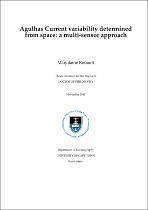JavaScript is disabled for your browser. Some features of this site may not work without it.
- ResearchSpace
- →
- Archives collection
- →
- Open Access Reports
- →
- View Item
| dc.contributor.author |
Rouault, Marjolaine J

|
|
| dc.date.accessioned | 2012-07-26T12:36:00Z | |
| dc.date.available | 2012-07-26T12:36:00Z | |
| dc.date.issued | 2011-11 | |
| dc.identifier.citation | Rouault, M.J. 2011. Agulhas Current variability determined from space: a multi-sensor approach. The University of Cape Town. | en_US |
| dc.identifier.uri | http://hdl.handle.net/10204/6010 | |
| dc.description | A thesis presented for the Degree of Doctor of Philosophy, Department of Oceanography, University of Cape Town. | en_US |
| dc.description.abstract | Satellite remote sensing datasets including more than 6 years of high frequency Sea Surface Temperature (SST) imagery as well as surface current observations derived from 18 years of merged-altimetry and over 2 years of Advanced Synthetic Aperture Radar (ASAR) observations are combined to study the variability of the Agulhas Current. The newly available rangedirected surface currents velocities from ASAR, which rely on the careful analysis of the measured Doppler shift, show strong promise for monitoring the meso to sub-mesoscale features of the surface circulation. While the accuracy of ASAR surface current velocities suffers from occasional bias due to our current inability to systematically account for the wind-induced contribution to the Doppler shift signal, the ASAR surface current velocities are able to consistently highlight regions of strong current and shear. The synaptic nature and relatively high resolution of ASAR acquisitions make the ASAR derived current velocities a good complement to altimetry for the study of sub-mesoscale processes and western boundary current dynamics. Time-averaged range-directed surface currents derived from ASAR provide an improved map of the mean Agulhas Current flow, clearly showing the location of the Agulhas Current core over the 1000 m isobath and identifying the region at the shelf edge of the north-eastern Agulhas Bank as one of the most variable within the Agulhas Current. To determine the variability of the Agulhas Current, an algorithm to track the position of the current is developed and applied to the longer merged-altimetry and SST records. | en_US |
| dc.language.iso | en | en_US |
| dc.relation.ispartofseries | Workflow;8426 | |
| dc.subject | Agulhas Current | en_US |
| dc.subject | Sea Surface Temperature | en_US |
| dc.subject | SST | en_US |
| dc.subject | Satellite remote sensing | en_US |
| dc.subject | Advanced Synthetic Aperture Radar | en_US |
| dc.subject | ASAR | en_US |
| dc.title | Agulhas Current variability determined from space: a multi-sensor approach | en_US |
| dc.type | Report | en_US |
| dc.identifier.apacitation | Rouault, M. J. (2011). <i>Agulhas Current variability determined from space: a multi-sensor approach</i> (Workflow;8426). Retrieved from http://hdl.handle.net/10204/6010 | en_ZA |
| dc.identifier.chicagocitation | Rouault, Marjolaine J <i>Agulhas Current variability determined from space: a multi-sensor approach.</i> Workflow;8426. 2011. http://hdl.handle.net/10204/6010 | en_ZA |
| dc.identifier.vancouvercitation | Rouault MJ. Agulhas Current variability determined from space: a multi-sensor approach. 2011 [cited yyyy month dd]. Available from: http://hdl.handle.net/10204/6010 | en_ZA |
| dc.identifier.ris | TY - Report AU - Rouault, Marjolaine J AB - Satellite remote sensing datasets including more than 6 years of high frequency Sea Surface Temperature (SST) imagery as well as surface current observations derived from 18 years of merged-altimetry and over 2 years of Advanced Synthetic Aperture Radar (ASAR) observations are combined to study the variability of the Agulhas Current. The newly available rangedirected surface currents velocities from ASAR, which rely on the careful analysis of the measured Doppler shift, show strong promise for monitoring the meso to sub-mesoscale features of the surface circulation. While the accuracy of ASAR surface current velocities suffers from occasional bias due to our current inability to systematically account for the wind-induced contribution to the Doppler shift signal, the ASAR surface current velocities are able to consistently highlight regions of strong current and shear. The synaptic nature and relatively high resolution of ASAR acquisitions make the ASAR derived current velocities a good complement to altimetry for the study of sub-mesoscale processes and western boundary current dynamics. Time-averaged range-directed surface currents derived from ASAR provide an improved map of the mean Agulhas Current flow, clearly showing the location of the Agulhas Current core over the 1000 m isobath and identifying the region at the shelf edge of the north-eastern Agulhas Bank as one of the most variable within the Agulhas Current. To determine the variability of the Agulhas Current, an algorithm to track the position of the current is developed and applied to the longer merged-altimetry and SST records. DA - 2011-11 DB - ResearchSpace DP - CSIR KW - Agulhas Current KW - Sea Surface Temperature KW - SST KW - Satellite remote sensing KW - Advanced Synthetic Aperture Radar KW - ASAR LK - https://researchspace.csir.co.za PY - 2011 T1 - Agulhas Current variability determined from space: a multi-sensor approach TI - Agulhas Current variability determined from space: a multi-sensor approach UR - http://hdl.handle.net/10204/6010 ER - | en_ZA |






